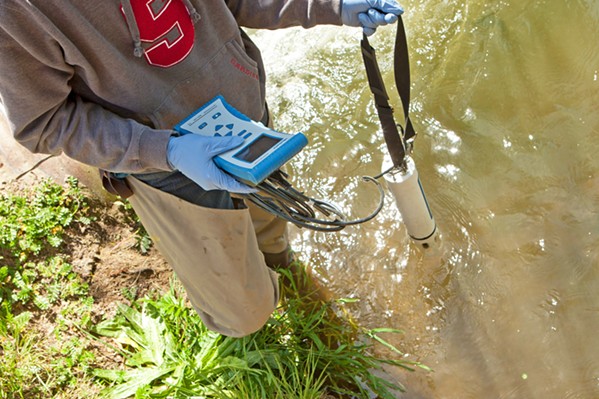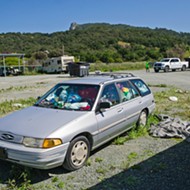Oso Flaco Lake remediation project will target 'persistent and pernicious' DDT pollution
By Peter Johnson[{
"name": "Newsletter Promo",
"id": "NewsletterPromo",
"class": "inlineCenter",
"insertPoint": "4",
"component": "15264767",
"requiredCountToDisplay": "0"
},{
"name": "Ad - Medium Rectangle CC01 - 300x250",
"id": "AdMediumRectangleCC01300x250",
"class": "inlineCenter",
"insertPoint": "8",
"component": "2963441",
"requiredCountToDisplay": "12"
},{
"name": "Ad - Medium Rectangle LC01 - 300x250",
"id": "AdMediumRectangleCC01300x250",
"class": "inlineCenter",
"insertPoint": "18",
"component": "2963441",
"requiredCountToDisplay": "22"
},{
"name": "Ad - Medium Rectangle LC09 - 300x250",
"id": "AdMediumRectangleLC09300x250",
"class": "inlineCenter",
"insertPoint": "28",
"component": "3252660",
"requiredCountToDisplay": "32"
}]
Nearly a decade after researchers found more DDT pesticides in Oso Flaco Lake than in any other water body in the state, local stakeholders are finally zeroing in on a project they say will help fix it.
The Coastal San Luis Resource Conservation District (RCD) is partnering with Teixeira Farms on a remediation project to reduce DDT levels in the scenic lake nestled between Santa Maria agricultural fields and the Guadalupe-Nipomo Dunes.
Hallie Richard, conservation programs manager for the Coastal San Luis RCD, told New Times that her agency is coordinating the effort because it's best suited to effectively navigate the sensitive and diverse mix of interests in the Oso Flaco Lake area.
"RCDs are special districts that have been around since the '30s," Richard said. "They've developed this really unique kind of adaptive ability to work and develop trusting relationships with farmers, ranchers, and land managers, but we also speak the language of the regulatory agencies."
In 2013, regulators tested the fish in Oso Flaco Lake for pesticide pollution as part of a statewide monitoring program and found that they contained extreme amounts of DDT—a toxic substance banned from use decades ago. The contamination at Oso Flaco turned out to be 10 times higher than that of the state's next most polluted lake in Watsonville, according to previous reporting.
"No one was illicitly using it—it was all legal," Richard said of the past use of DDT. "But it's so persistent and pernicious. DDT is sediment bound. It has a half-life of over 50 years, but that half-life is extended when it's in an anaerobic condition. Oxygen isn't coming in."
Richard explained that the sediment-bound DDT is carried into the lake via Oso Flaco Creek, which flows across the nearby farm fields. Once in the lake, it's passed through the food chain, all the way up to birds and potentially humans who eat the fish.
Because the lake doesn't have a consistently open outlet into the ocean, it acts like a "sink" and makes it even more difficult for pesticides to break down. The U.S. Environtmental Protection Agency (EPA) lists Oso Flaco Lake as an "impaired water body," and follow-up testing in 2017 found that DDT and other chemicals were present in the top half-foot of soil, down to a depth of 4.5 feet.
While pesticide pollution is clearly an issue, arriving on a feasible and agreeable solution has been a big challenge, Richard said. It's taken years of negotiating with farmers and regulators like the Central Coast Regional Water Quality Control Board and the EPA to arrive at a remediation project.
"It really took since 2013 to slowly start discussing how the solution might look. It's just been meetings—meeting in the ag fields, regulatory offices, talking about how to come to the middle," she said.
Leveraging a $600,000 state grant and cooperation from Teixeira Farms, the RCD is proposing a multi-pronged solution that Richard said tries to target the source of the pollution: the fields and creek.
The project involves the removal of more than 25,000 cubic yards of sediment across a 1.2-mile stretch of Oso Flaco Creek. That material will be excavated, trucked, and dumped onto a 26-acre plot of Teixeira Farms-owned land for remediation. Turning the soil "every month or so" will help incorporate more oxygen and break down the DDT.
"Just by taking the sediment, draining the water out of it, and spreading it on a farm field, that accelerates the breakdown of DDT," Richard said. "There's a certain concentration that's acceptable for human exposure or growing crops. We're pretty confident we can reach that quickly. Once the soil has met that threshold, the Teixeira farm is free to continue farming it."
Teixeira Farms declined to comment for this story, but Richard praised the company for being an "early adopter" of practices that will help reduce the amount of DDT flowing into the Oso Flaco Lake system.
A second aspect of RCD's project also involves Teixeira Farms. The company has agreed to install a 1-acre sediment basin on its land where creek water will be pumped in to allow the DDT-laden sediment to "drop out of suspension," according to project planning documents. Then, the treated water will be discharged back into the creek.
Richard said that sediment basins are just one farming practice that can help reduce the flow of sediments into the creek and lake. It also has an added benefit for farmers.
"By removing the sediment in the creek, we're increasing flood capacity," she said. "That's definitely the carrot that encouraged them to participate in this project."
Some other practices that could help with the pollution, though, are infeasible for one reason or another, she added. Food safety regulations, for example, make it unlawful to line tailwater ditches with grass (which could trap sediment), since that vegetation would be located too close to crops.
"[The regulations] conflict all the time," Richard said.
A final component of the RCD project is to modify a creek culvert near Oso Flaco Road that has been identified as a major source of erosion.
"The creek takes a really sharp, unnatural 90-degree turn when it goes under the road," Richard said. "We're to get funding to fix that area—to increase the size of the culvert and to realign it so the creek has a more natural alignment. That's going to make the biggest impact in terms of sediment loading."
Richard noted that the project still has some budgetary and regulatory hurdles to clear before the RCD and its partners can get started on it. Officials are aiming for May 2023 as an early target. She also noted that the proposed remedies will not be a cure-all for DDT pollution in Oso Flaco Lake.
More comprehensive fixes—like a full-scale dredging of Oso Flaco Lake—are cost prohibitive. The lake is too shallow for a "capping" project, which involves installing a thin layer of benthic clay over the contaminated lake bottom.
Cleaning up the watershed will instead require ongoing collaborations between farmers, regulators, and conservation agencies like the RCD.
"We're looking at this effort as kind of a proof of concept. A demonstration, if you will," Richard said. "That one sediment basin we're building will be kind of a demonstration tool to say, 'Hey, it didn't take up that much farmland. It works well. It will maintain your flood capacity.' Hopefully, that will result in other farms adopting them." Δ
Assistant Editor Peter Johnson can be reached at [email protected].
Latest in News
Readers also liked…
-

Coast Unified teachers upset over new position's salary and qualifications
Oct 20, 2022 -

SLO police identify alleged driver who hit and killed couple
Dec 22, 2022 -

When the levee breaks: Oceano residents, county officials walk a tightrope of regulations to manage Arroyo Grande Creek, which some say led to the levee's failure in January
May 18, 2023










